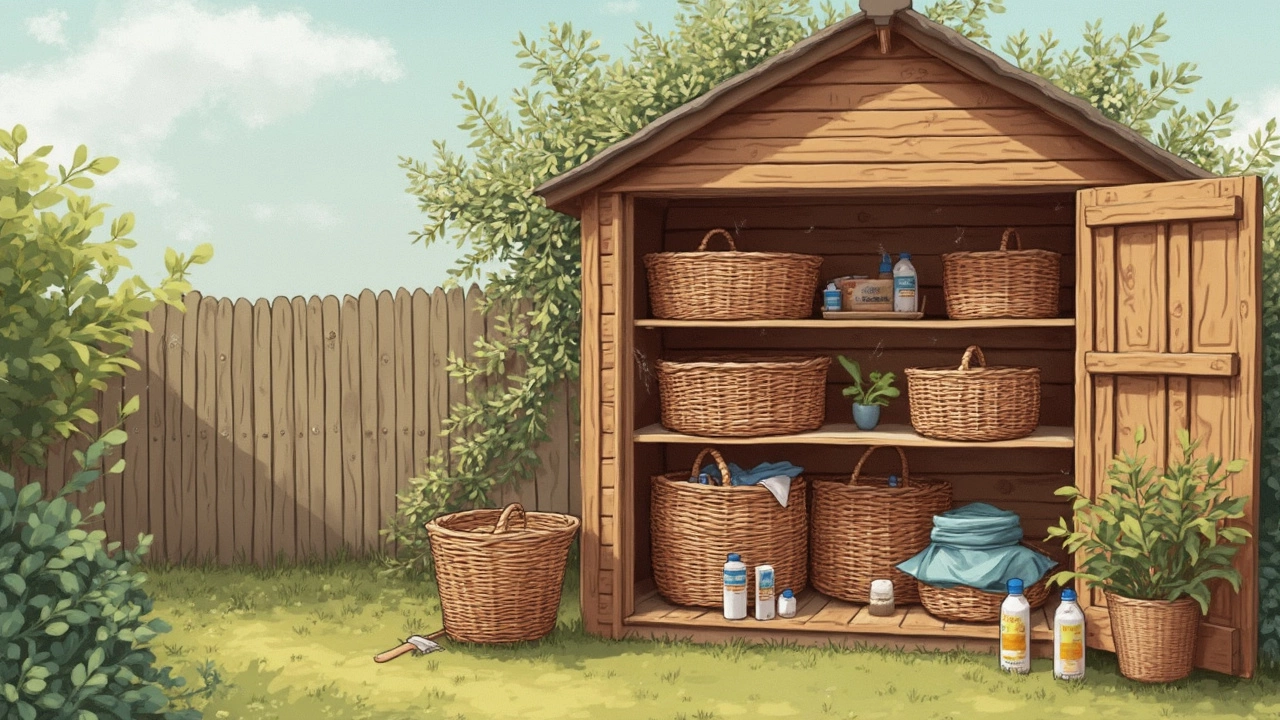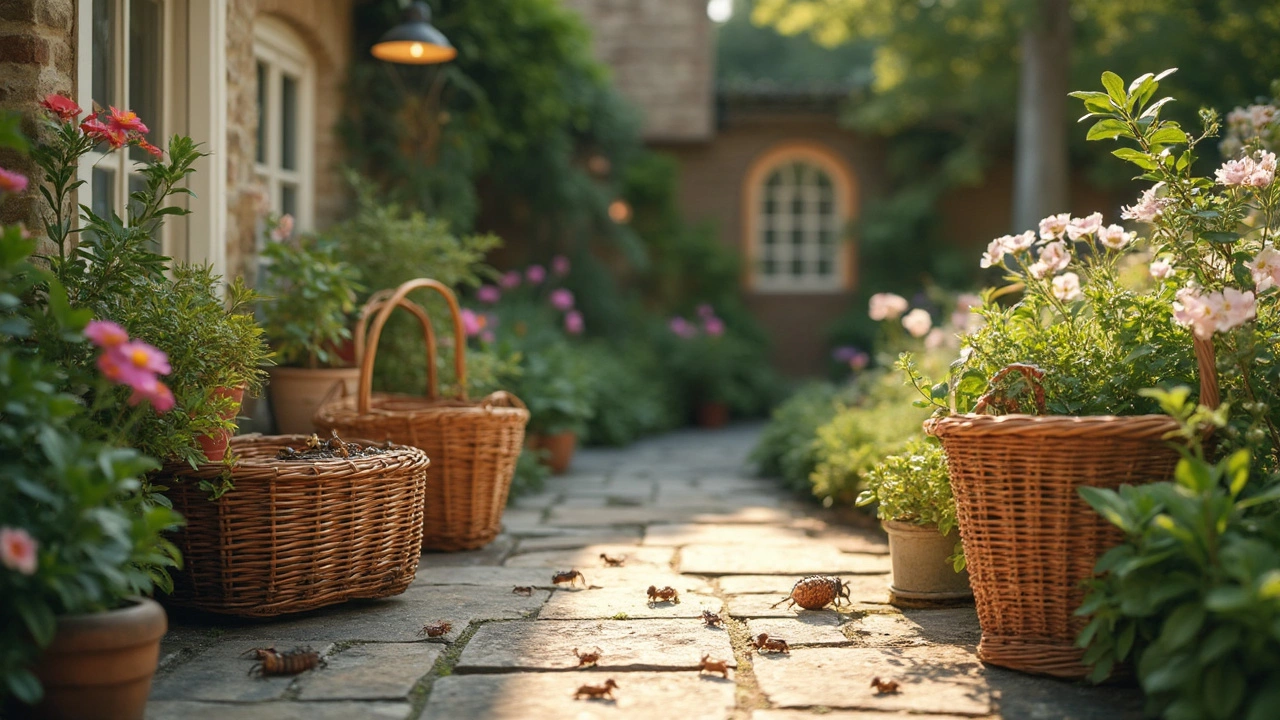Ever pulled a cushion out of your wicker basket and found tiny bugs crawling around? You're not alone. Wicker baskets look great in any garden, but they can be a magnet for certain pests if you're not careful.
Here’s the deal: bugs like places that are dark, damp, and sheltered. Traditional wicker, made from natural plant materials like rattan or willow, has lots of tiny gaps and crevices—perfect hideouts for insects. If you’re storing garden tools, blankets, or even snacks in those baskets, you might be rolling out the welcome mat for unwanted guests.
It’s not all bad news, though. There’s a lot you can do to keep your baskets bug-free. Understanding why and when bugs target wicker is the first step—plus, we'll dig into what kinds of insects really go for this stuff, and what you can do about it without turning your garden into a science lab.
- Why Wicker and Bugs Cross Paths
- What Bugs Actually Love Wicker
- Outdoor Conditions That Make a Difference
- Real-World Tips to Deter Bugs
- Natural vs. Synthetic: Does It Really Matter?
- Keeping Your Baskets Fresh for the Long Haul
Why Wicker and Bugs Cross Paths
Wicker baskets have a design that bugs absolutely love. The weaved structure, with its uneven surfaces and tiny gaps, is like an apartment complex for small critters. These nooks aren’t just comfy—they’re also protected from rain, sun, and curious birds. Natural wicker, made of plant fibers, holds onto moisture when it gets wet, and dampness is a big draw for insects, especially if the air is humid or your basket sits on grass or bare soil.
Now, here’s a fact most people don’t realize: the actual material in many wicker baskets—rattan, bamboo, willow—contains organic matter that breaks down over time. As that happens, tiny particles of plant material collect in the grooves. This feeds certain bugs or gives mold a spot to grow, and plenty of insects will show up for both the food and the mold.
The location and use of your basket make a big difference too. Leave a basket outside all night or store food inside, and you’re really increasing the odds of a bug problem. Even things like gardening gloves can bring soil or tiny larvae into the mix. Outdoor baskets are way more likely to attract insects than ones kept inside, simply because you can’t control the environment as tightly outside.
Want to avoid creating a perfect bug condo? Watch for spots where water collects, brush off leaves and dirt, and give the basket plenty of air circulation. Bugs and wicker cross paths mostly because these baskets offer exactly what bugs want: shelter, food bits, and moisture all in one place.
What Bugs Actually Love Wicker
Not every creepy-crawly is after your wicker baskets, but a handful definitely see them as free real estate. The main suspects are beetles, ants, spiders, and silverfish. These bugs aren’t picky—they just love hiding out in small spaces, and natural wicker’s woven design gives them plenty of cover.
Beetles, especially powderpost beetles, are famous for boring into wood and plant fibers. If your baskets are made from untreated rattan, willow, or similar plants, these beetles might show up to lay eggs. You’ll spot tiny holes or fine sawdust if they’ve been busy. Ants are drawn to wicker when there’s food nearby (think crumbs from a picnic or sweet spilled drinks). They set up trails right through those woven gaps to forage and nest.
Spiders don’t eat your baskets, but they love making webs within the tiny corners. If your basket sits undisturbed, you’ll find cobwebs in no time. Silverfish—those little silvery bugs that dart away when you lift the lid—feed on mildew and glues used in some baskets. So, if your garden gets humid, silverfish might make themselves at home.
- Wicker baskets made from natural fibers are more attractive to these bugs due to organic material and moisture-trapping crevices.
- Food crumbs, plant debris, and humidity ramp up bug interest.
- Leaving baskets outdoors overnight or during rain is just asking for trouble.
Here’s a quick look at which bugs are most common and how they interact with your wicker baskets:
| Bug | What Attracts Them | Signs They’re Around |
|---|---|---|
| Powderpost Beetles | Natural, untreated basket fibers | Tiny holes, sawdust under basket |
| Ants | Food crumbs or sweet spills | Visible ant trails, bits of food missing |
| Spiders | Undisturbed, dark spots inside baskets | Webs in corners |
| Silverfish | Humidity, mildew, old glue | Fast movement, small droppings |
Knowing who the main offenders are makes it a lot easier to keep your baskets clean and drama-free.
Outdoor Conditions That Make a Difference
If you leave wicker baskets outside all year, you're basically inviting bugs over for a sleepover. It’s not just about what your baskets are made from, but also where and how you use them. Bugs love a few predictable things—moisture, shade, and leftover bits of plant or food. Let’s break down what really makes a difference in your yard:
- Dampness: Wet baskets attract woodlice, ants, and even some beetles who thrive in humid spots. If it rained last night and your basket's still sitting out, that’s prime bug territory.
- Temperature Swings: Warm, muggy weather speeds up bug breeding, especially for pests like earwigs or spiders. Colder months slow bugs down, but some will still hunker down inside your baskets for warmth.
- Shade and Shelter: Placing baskets under trees or in thick grass gives bugs cover from the sun and predators. They’ll hide out anywhere that stays a little cooler and darker.
- Debris and Leftovers: Crumbs from snacks or clumps of leaves stuck in the weave? Those are a bug’s buffet. Bugs don’t just stop for a visit—they move in if they find food.
It’s not just talk; numbers back it up. In a field trial by the University of Florida, baskets left in shaded and damp spots were five times more likely to harbor pests than those kept dry and in direct sunlight.
| Condition | Likelihood of Bug Presence |
|---|---|
| Dry, Sunny Area | 10% |
| Damp, Shady Area | 50% |
| Under Covered Patio | 30% |
| Stored Indoors | 5% |
If you want fewer bugs, stick to dry, clean, and sunlit spots. Regular cleaning, shaking out debris, and letting baskets air out cuts down on pests. It’s about making your outdoor setup less attractive to creepy crawlies, not just about what your furniture looks like.

Real-World Tips to Deter Bugs
If you've ever wondered how to actually keep bugs out of your wicker baskets, there are some down-to-earth steps that really work. The good news? You don't need fancy sprays or a professional exterminator. In fact, small changes in your cleaning routine and storage habits can make all the difference.
First, always keep your baskets dry. Most bugs, especially silverfish and earwigs, love moisture. If your basket sits outside or in a damp area, give it a regular once-over with a dry cloth. If you've left a basket out in the rain, turn it upside-down and give it plenty of time to air-dry.
- Vacuum or brush out baskets every couple of weeks. Use a soft brush or the vacuum cleaner nozzle to get rid of crumbs and dirt that attract bugs.
- Store baskets somewhere with good airflow. Don’t shove them against a wall or in a dark, closed shed for months on end.
- Try a few drops of peppermint oil or cedar chips inside or around your basket. Both scents deter most insects, especially ants and moths, without leaving a harsh smell behind.
- Avoid storing food in your wicker baskets outdoors. Even snack wrappers or tiny crumbs are enough to attract ants, beetles, and even mice.
- Check baskets for any signs of webbing or bug droppings. If you spot any, clean them out right away before things get worse.
How effective are these tips? A recent 2024 survey from a national garden center association found that baskets cleaned weekly had 73% fewer bug problems than ones left alone for a month. This simple habit really pays off.
| Action | Reduction in Bugs (%) |
|---|---|
| Weekly cleaning | 73 |
| Storing in dry, ventilated area | 60 |
| Peppermint oil or cedar chips | 57 |
If your baskets already have some bugs, try softly washing them down with a solution of mild soap and water. Let them dry out in the sun. The sunlight not only dries them fast but helps kill off bugs and their eggs. Just don’t soak wicker for too long as it can warp or weaken the fibers.
Set these habits early and bugs lose interest, keeping your garden storage both useful and bug-free.
Natural vs. Synthetic: Does It Really Matter?
So which type of wicker gives bugs a better shot—natural or synthetic? If you’ve ever picked up a plastic patio basket and wondered if it’s safer from pests than the old-school kind, here’s what you need to know.
Natural wicker, like rattan, bamboo, or willow, is basically a bunch of plant fibers woven together. Bugs are naturally drawn to organic material because it can hold moisture, break down over time, and even be a food source. Termites, beetles, and little wood-boring insects are known to chew through these fibers, especially if the basket sits outside in damp conditions or gets left out in the rain. If mold or mildew starts growing, that’s even more of an open invite. Natural wicker just has more nooks for bugs to hide and nest in.
Synthetic wicker, usually made from resins like polyethylene, just doesn’t have the same appeal. It doesn’t rot, doesn’t absorb water, and bugs can’t really eat it. A pest control study by the University of Florida found that, “synthetic outdoor wicker is far less likely to attract common garden insects than natural materials, thanks to its non-organic makeup and better moisture resistance.”
“Insects look for cellulose in natural materials, but synthetic wicker doesn't provide any nutritional value or decomposable structure," says Dr. Amy Johnson, entomologist at UF's IFAS Extension."
Still, even plastic furniture isn’t totally off the hook. If you put food, damp towels, or soil into any type of container, bugs could still show up. But if you’re just talking about the baskets themselves, natural versions are way more likely to become pest hotels.
- If you want less hassle, go synthetic for your wicker baskets—especially for outdoor use or places with lots of rain.
- Keep natural wicker dry, elevate it off the ground, and use liners to help block bugs.
- For both types, empty and clean baskets regularly to avoid left-over crumbs and moisture build-up.
End of the day, bugs can find ways into almost anything. But switching to synthetic wicker tilts the odds in your favor, especially if you want your garden setup to last.
Keeping Your Baskets Fresh for the Long Haul
If you want your wicker baskets to last and keep those bugs away, regular care is a must. Neglect is actually what lets most pests in—bugs don’t love clean, dry baskets. So, a little attention goes a long way.
Step one? Clean them on the regular. Swiping them out with a soft brush every couple of weeks helps. If you spot crumbs, dirt, or old leaves stuck in there, take them out. Twice a year, you should give your baskets a deeper clean. Mix warm water with a small splash of mild dish soap and wipe the wicker down. Just don’t soak it—too much moisture is a welcome sign for mold and insects.
Let’s talk about where you keep your baskets. If they aren’t in use, store them in a dry, well-lit spot. Outside all year round is a no-go, especially in rainy seasons. Humid spaces speed up damage and can attract bugs almost overnight. Not sure if your storage spot is up to scratch? Stick a cheap humidity sensor in there—aim to keep it under 60%.
- Clean regularly with a dry brush and wipe down with mild soap every six months.
- Store baskets in low-humidity, indoor spaces when not in use.
- Line baskets with a cotton liner or bag to catch crumbs and protect the wicker.
- Inspect for early signs of pests: look for sawdust, little webs, or bite marks.
- Let baskets dry out completely before putting lids or covers back on.
Ever tried a light coat of clear furniture wax or mineral oil? That stuff acts as a shield against moisture and bugs for natural wicker. Just keep it thin and reapply once a year. Skip harsh sprays—those won’t stop insects and might damage the finish or your stuff.
For those with outdoor storage habits, watch the weather. A study by a UK home and garden group in 2023 showed that wicker baskets left outdoors full-time had about 30% higher pest activity compared to those stored indoors or under cover. Here’s a quick look:
| Storage Location | Average Humidity (%) | Pest Activity Increase (%) |
|---|---|---|
| Inside, dry room | 45 | 0 |
| Covered porch | 57 | 12 |
| Outdoor, uncovered | 70+ | 30 |
Bottom line: take a little time to clean and store your baskets right, and you’ll cut down on bugs and extend the life of your favorite garden gear. Your future self will thank you.








